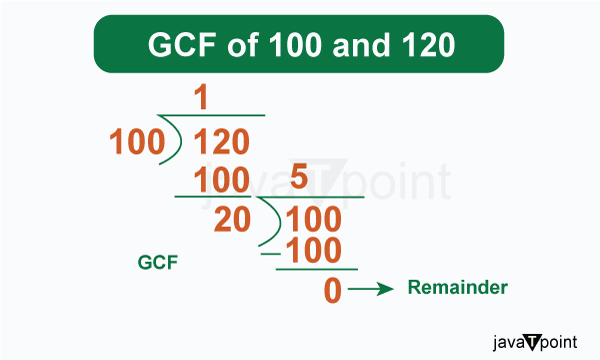of 100 and 120In the field of Mathematics, numbers play a fundamental role in solving problems and understanding patterns; one such concept often used by us is the determination of the (GCF) greatest common factor between two or more than two numbers. In this article, we will get to know and understand the interesting concept of GCF, and after that, we will understand how to calculate GCF of 100 and 120; we will also get knowledge about the methods to find GCF and the applications of the greatest common factor. 
Understanding Greatest Common Factor (GCF)The Greatest Common Factor (GCF) is the largest positive number that can divide those two or more numbers (without leaving any remainder), whose GCF we are calculating; GCF is also known as "Greatest Common Divisor (GCD)." It holds significant value in many mathematical fields, including algebra, number theory, and cryptography; the GCF is the foundation for simplifying fractions, solving equations, and calculating common factors. Factors of 100 and 120To find the GCF of 100 and 120, first, we have to find the factors of each number; a factor of a number is an integer that divides the numbers evenly and without any remainder.
Determining the GCFTo find the GCF or GCD of 100 and 120, we need to see the common factors that are common (shared) in both numbers. As we know all the factors of 100 and 120, we can separate common factors, which are 1, 2, 4, 5, 10, and 20. But as per the name "greatest common factor," we are looking for the largest (greatest) integer from those common factors, which in this case is 20. So, the GCF (greatest common factor) of 100 and 120 is 20. Methods to Find the GCF of 100 and 120There are mainly three methods to calculate or find the greatest common factor of 100 and 120, that are:
1. Using Euclidean Algorithm The Euclidean Algorithm provides an effective way to calculate the GCF of two numbers. According to the algorithm, GCF (X, Y) = GCF (Y, X mod Y), where X Y and "mod" represents the modulus operator. Let's apply the Euclidean Algorithm to find the GCF of 100 and 120:
Therefore, the GCF of 100 and 120 is 20. 2. Long Division Method The GCF of 100 and 120 can also be determined by the use of long division, by repeatedly dividing until the remainder becomes zero (0).
The divisor obtained in the last step, which is 20, represents the GCF of 100 and 120. 3. Prime Factorization Method In this method, we first find the prime factors of each number. So, the prime factor of 100 is 2 x 2 x 5 x 5, and the prime factor of 120 is 2 x 2 x 2 x 3 x 5. Then we have to see and write the common factors from both the prime factors; as we can see that 2 x 2 x 5 is the common prime factor of 100 and 120. Therefore, the GCF of 100 and 120 is obtained by multiplying these common factors, which gives us 2 � 2 � 5 = 20. Applications of GCFThe concept of GCF extends beyond simple arithmetic and finds applications in various real-world scenarios.
ConclusionWe can say that GCF of 100 and 120 is 20; by exploring divisibility, factors, and prime factorization, we all have better understood the concept of GCF. By gaining this knowledge, we get the opportunity to explore the field of Mathematics further and help in problem-solving in various fields; by sharpening our skills in finding the GCF, we can enhance our knowledge of Mathematics and unlock new skills in analyzing numbers.
Next TopicRoman Numerals 1 to 100
|
 For Videos Join Our Youtube Channel: Join Now
For Videos Join Our Youtube Channel: Join Now
Feedback
- Send your Feedback to [email protected]
Help Others, Please Share










